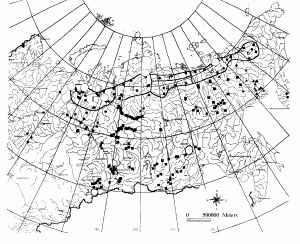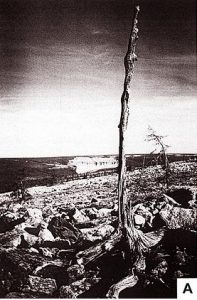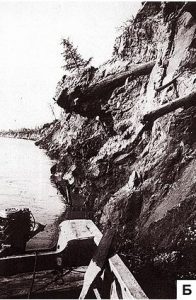Sukachev Institute of Forest, SB RAS, Krasnoyarsk
Head of the Institute:
Eugene A.Vaganov, Academician of the RAS
Academgorodok, Krasnoyarsk, 660036, Russia
Tel.: (7)(3912)431429, (7) (3912) 433686
Fax: (7)(3912)433686
email: ifor@krsk.infotel.ru
Principal researchers:
E.A.Vaganov, Academician
M.M.Naurzbaev, Senior Researcher
V.V.Shishov, Researcher
A.V.Kirdyanov, Researcher
D.V.Ovchinnikov, Post-graduate student
Project objectives
The comparative analysis of summer temperature variations in high latitudes and South Siberia Mountains reconstructed by supralong (up to 2 millennia) tree-ring chronologies makes it possible to find out common for the vast territory of Siberia long-term and short-term temperature changes, to correlate them with the other indirect data of temperature variations in North Hemisphere; it sufficiently enriches International and Russian data base on the Holocene climate change; allows to create models of forest growth response to climate changes; to evaluate the range of polar and upper tree line movement during the last millennia.
In the project the greatest attention will be paid to quantitative reconstruction of summer temperature on the basis of several indices of tree-ring chronologies: annual tree-ring width variability, wood density, cell sizes and cell wall thickness. The analysis of these characteristics in complex allows to increase greatly time scale resolution of dendroclimatic reconstructions obtaining data not only for year but for seasons separately.
Background and significance of objectives
At present there are two directions of intensive Earth climate history researchers in the Holocene with the help of indirect information sources. First, this is a creation of net and data base on the terrestrial globe with long rows of measurements (instrumental records, tree-rings, lake sediments, ice cores, coral growth layers etc.) to reconstruct spatial-temporal temperature and precipitation variability (Mann et al., Nature, 1998, 392:779-782). Secondly, this is comparison of quantitative climate reconstruction with high temporal resolution (year, season) for selected regions obtained from various indirect sources (Briffa et al., Nature, 1998, 391:678-682; Jones et al., Holocene, 1998, 1998, 8(4):455-471).
Creation of supra-long (several millennia) tree-ring chronologies in key regions of Siberia for evaluation of natural North Hemisphere climate changes is of most importance in these works. Reconstruction obtained with their help allow not only to find out and evaluate climate fluctuations, but to be used to calibrate and to date other indirect sources with low temporal resolution or being problematic in absolute dating.
Laboratory of Dendrochronology of V.N.Sukachev Institute of Forest SB RAS has great experience in creation of long-term chronologies as well as in revealing and analysis of climatic components of tree growth changes. A net of dendroclimatic stations was created on the whole territory of Siberia for the last decade (Fig. 1), which made it possible to carry out spatial-temporal reconstruction of temperature changes and to make up maps of summer temperature anomalies for the Siberian Subarctic since 1610 up to 1990 (Vaganov et al, 1996). On the territories where well-preserved wood remains and subfossil wood from alluvial deposits were found the works on creation of millennium chronologies started (Fig. 2) (Vaganov et al., 1997, 1999; Naurzbaev, Vaganov, 1999). A lot of preserved wood remains in continental regions of Siberia (close to glaciers in the Altai and upper forest border in Stanovoye Upland) are found as well. With the help of equipment of densitometrical laboratory and image system for cell wood structure of tree-rings the measurements of annual tree-ring characteristics additional to tree-ring width made which allowed to obtain information of intra-annual changes of climatic variables. For this purpose special, original simulation models were worked out, there are also worked out models of reconstruction of temperature and precipitation during growth season by annual tree-ring structure characteristics (by wood density profile, by cell lumen and cell wall thickness) (Vaganov et al., 1994, 1996). The created dendroclimatic data base for Siberia is constantly being widened.
Research plan: approaches and methods
The investigation methods include a set of experimental measurements, traditional for dendrochronology and dendroclimatology and widely used in world chief laboratories, and statistical approaches (site selection and material collection, annual tree-ring characteristics measurements by automatic devices and in densitometrical laboratory, cross-dating procedure, standardization of raw measurements and climatic signal discharge, estimation of climatic functions, creation of simple and multiple regression models of leading climatic factors reconstruction, spectral analysis of long-term temporal chronologies etc.) as well as worked out unique methods of annual tree-ring measurements and computer programs of raw data processing (automatic systems usage and systems for image analysis to measure cell structure of annual tree-rings, usage of simulation models of annual tree-ring formation by daily temperature, moisture and solar radiation changes, statistical multiple methods to reconstruct intraseasonal variability of climatic factors inferred from characteristics of annual tree-ring structure etc.) (Fig. 3). The latter are not only pioneer but also define priorities of Laboratory of Dendrochronology of Institute of Forest SB RAS in world dendroclimatology.
Expected results
Obtaining and dendroclimatic analysis of 2-millennia tree-ring chronologies by variations of width and structure of annual rings for two regions of subarctic territory (eastern Taymir and the lower Indigirka River) and continental part of Siberia (the Altai, Stanovoye Upland):
- construction of absolutely dated chronologies, represented by not less than 15 trees for each temporal interval;
- climatic signal discharge and statistical analysis of its temporal changes;
- reveal of main climatic variables defining growth and structure changes in annual tree-rings in the areas under investigation with the help of multiple regression and simulation models;
- creation of the reconstruction models and reconstruction of temperature changes by chronologies characteristics;
- measurement of density variations and cell structure of annual rings to widen a set of parameters applied in summer temperature reconstruction;
- analysis of annual ring width and structure variation by means of simulation model to find out main climatic factors defining tree growth.
Revealing of coincident long-term and high frequency variations of temperature in subarctic area and continental part of Siberia for 2 millennia by methods of principal component analysis and spectral analysis:
- reveal of years with extreme temperature;
- synchrony of long-term temperature changes, reveal of global and regional components;
- estimation of range of natural temperature fluctuations in order to reveal the modern temperature trends;
- reveal and estimation of anthropogenic component of temperature changes in subarctic and continental regions of Siberia.
Usage of tree-ring chronologies and climatic reconstruction to calibrate the other indirect climatic data and to compare with climatic reconstruction based on ice core, lake sediment, pollen and other paleobotany data:
- estimation of range of natural temperature variations revealing by different proxy records;
- synchrony and asynchrony in long-term climatic changes by means of different proxy records;
- maps of temperature and precipitation distribution through Siberia for different time intervals during last millennia of the Holocene.
List of publications of participants related to the project
-
Âriffa K.R., Jones P.D., Schweingruber F.H., Karlen W., Bartholin T., Shiyatov S., Vaganov E.A., Zettenberg P., Eronen M. Regional temperature patterns across Northern Eurasia: tree-ring reconstructions over centuries and millennia // Int. Conf.on Past, Present and Future Climate. – SILMU, Helsinki, 1995. – P. 115-118.
-
Vaganov E.A. Mechanisms and simulation modeling of tree-ring formation // Lesovedenie. – 1996. – ą 1. – P. 3-17. (in Russ.)
-
Panjushkina I.P., Vaganov E.A., Shishov V.V. Statistical characteristics analysis of larch growth variability in North of Central Siberia // Geography and Natural Resources. – 1996. – ą 4. – P. 93-103. (in Russ.).
-
Panyushkina I.P., Vaganov E.A., Shishov V.V. Spatio-temporal variation of radial tree growth in relation to climate in the North of Middle Siberia // Dendrochronologia. – 1996. – ą 14. – P. 115-126.
-
Vaganov E.A., Naurzbaev M.M., Schweingruber F.H., Briffa K.R. and Moell M. An 840-year tree-ring width cronology for Taymir as an indicator of summer temperature changes // Dendrochronologia. – 1996. – ą 14. – P. 193-205.
-
Vaganov E.A. Record of current century warming by tracheids of tree-rings // Proc. of the Acad. Sci. – 1996. – Vol. 351, ą 2. – P. 281-283 (in Russ.).
-
Vaganov E.A., Shiyatov S.G., Mazepa V.S. Dendroclimatic Study in Ural-Siberian Subarctic. – Novosibirsk: Nauka, 1996. – 246 p. (in Russ).
-
Panjushkina I.P., Vaganov E.A., Shishov V.V. Dendroclimatic analysis of larch growth variability in the North of Central Siberia // Geography and Natural Resources. – 1997. – ą 2. – P. 80-90.
-
Vaganov E.A. Dendrochronology as a tool to study global and regional processes. In: Proc. East Asia Workshop on Tree-Ring Analysis / Ed. W-K.Park, Publ. Chungbuk. Nat. Univ., Cheongju, 1997. – P. 1-14.
-
Vaganov E.A., Panjushkina I.P.,Naurzbaev M.M. Reconstruction of summer air temperature in eastern part of Taymir over last 840 years // Russ. J. Ecol. – 1997. – Vol. 28, ą 6. – P. 355-359.
-
Koshkarova V.L., Vaganov E.A., Koshkarov A.D. Spatial-temporal dynamics of forest vegetation in Central Siberian Subarctic during last 9,000 years // Proc. of the Acad. Sci. – 1997. – Vol. 355, ą 5. – P. 712-715.
-
Briffa K.R., Schweingruber F.H., Jones P.D., Osborn T.J. Shiyatov S.G., Vaganov E.A. Reduced decadal thermal response in recent northern tree growth // Nature. – 1998. – ą 391. – P. 678-682.
-
Briffa K.R., Schweingruber F.H., Jones P.D., Osborn T.J., Harris I.C., Shiyatov S.G., Vaganov E.A., Grudd H. Trees tell of past climates: but are they speaking less clearly today? // Phil. Trans. R. Soc. London. B. – 1998. – ą 353. – P. 65-73.
-
Vaganov E.A., Shiyatov S.G., Hantemirov P.M., Naurzbaev M.M. The summer temperature variation in high latitudes of the northern hemisphere during last 1,5 thousand years: a comparative analysis of tree-ring data and ice cores // Proc. of the Acad. Sci. – 1998. – Vol. 338, ą 5. – P. 681-684. (In Russian).
-
Vaganov E.A., Shiyatov S.G. The importance of dendroclimatic and dendrohydrological researches to study of global and regional ecological problems // Sib. J. Ecol. – 1999. – Vol. 6, ą 2. (In Russian).
-
Naurzbaev M.M., Vaganov E.A. 1957 – year tree-ring chronology of eastern part of Taymir // Sib. J. Ecol. – 1999. – Vol. 6, ą 2. (In Russian).
-
Ovchinnikov D.V., Vaganov E.A. Dendrochronological chracteristics of Siberian larch (Larix Sibirica L.) from upper tree line in Altai mountains // Sib. J. Ecol. – 1999. – Vol. 6, ą 2. – P. 145-152.
-
Vaganov E.A., Kirdyanov A.V., Silkin P.P. The importance of early summer temperature and dates of snow melting for growth of trees in Siberian Subarctic // Rus. G. Forestry. – 1999. – 6 (in press).
Fig. 1. A network of stations for dendroclimatic monitoring of the boreal forests of Siberia (large circles stand for where supralong chronologies are created)).
Fig. 2. Remains of larch trunks on the surface (A) and semi-fossil timber in alluvial sediments (B).
Fig. 3. Cellular structure of tree-rings (A) and fragments (B) of chronologies with respect to cell size (1) and cell wall thickness (2).




